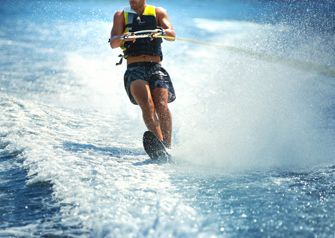
News
Tips for Preventing Water Sport Injuries
Date posted: 7/18/2019
Last updated: 7/18/2019
It’s summertime in Chicago (finally!) and many of us are flocking to area lakes and rivers to enjoy water sports, like waterskiing, tubing and wakeboarding.
But, a recent study shows that overall, water sports injuries have a similar in-hospital mortality rate as motor vehicle collisions. And, water sport injuries are more likely to result in penetrating trauma and more likely to require surgical intervention.
A second study shows that tubing, a seemingly harmless activity that involves someone in an inflatable tube being pulled by a motor boat, can be just as dangerous as other water sports like water skiing and wakeboarding.
Most common injuries
- Wakeboarding—and tubing—related injuries most often affect the head and neck, while waterskiing injuries cause strain or sprain to the knees, shoulders and ankles. High-speed sports such as jet skiing, surfing and kiteboarding have potential for impact with a board and can cause concussions and fractures.
- Wakeboarders are most likely to injure their head and neck, including sustaining a concussion. A wakeboarder can “catch an edge,” throwing him hard into the water, and slamming his head. ACL injuries and ankle sprains are very common in wakeboarding.
The most common waterskiing injuries include hamstring strains, ankle sprains, ankle fractures, osteochondral lesions of the talus, and Achilles tendon ruptures. The skier’s ankles are bound to the skis, so the impact of a fall can place a lot of pressure on the ankle as the skis go in one direction and the skier’s body the other direction.
Who gets injured?
Research has demonstrated that injuries are not necessarily related to inexperience. Studies have shown that musculoskeletal injuries from water sports don’t just occur in our novice participants, but advanced and professional competitors sustain similar injuries.
Prevention tips
Dr. Brian Cole, who last month sustained a hamstring tear while wakesurfing himself, has tips for water sport lovers:
- Stay hydrated: The musculoskeletal system, specifically your muscles, work best when they are hydrated. Dehydration leads to muscle cramping, strains or tears. For vigorous water sport activity, a combination of water and electrolyte beverages is best.
- Stretch: Treat water sports like any other and warm up before taking the plunge. Stretching increases your range of motion and prevents injury and muscle strains. This is especially important given the high incidence of hamstring strains.
- Water safety: Wear a life jacket whenever you’re on or in the water. Even the best swimmers and athletes can become fatigued. Most people know that a life jacket is required when riding in a boat or on a jet ski, but the U.S. Coast Guard has determined that stand up paddle board riders now require life jackets.
- Know your limits: Like all sports, waterskiing, wakeboarding, kite boarding and surfing all take practice. Take it slow and increase the intensity at a steady pace.
- Wear a helmet: Depending on the sport, wear a helmet to avoid head injury. It’s always better to be safe and protect yourself against head injuries and concussions.
- Take a break: If you have an injury or a muscle strain, back off the intensity or stop entirely so that your injury has time to heal.
Keep safety in mind this summer—and have fun on the water!


